Candidates of New Objects
|
Here shows candidates of new objects discovered in the Ageo Survey.
Most of them are detected automatically by the PIXY system.
|
|
The candidates are numbered from 1 in each year.
After the number, one alphabet is added to show the type of the object.
Each alphabet code means as follows.
| C | Comet |
| A | Asteroid |
| N | Nova |
| S | Supernova |
| V | Variable star |
| F | Flush event |
|
|
 AGEO 1999-081V
AGEO 1999-081V
R.A. 20h29m56s.99 Decl. +39o53'36".5 11.7C mag
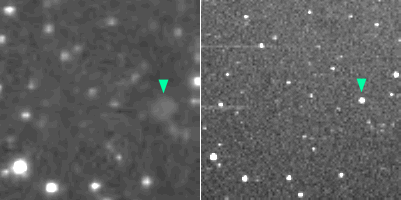 This is a candidate of new object automatically detected by the PIXY system from the survey images on June 5.
Because no star was detected from the 300-mm camera lens images of Comet C/1998 M5 (LINEAR) on Sept. 12, 1998, it was output as a candidate of new object.
However, we can see a very diffused image at that position on the left image.
Many stars become diffused, like this one, on images taken with a CCD and camera lens.
When a star becomes extremely diffused, it is hard to find the star on the image.
Therefore, be careful to compare camera lens images with reflector images.
This is a candidate of new object automatically detected by the PIXY system from the survey images on June 5.
Because no star was detected from the 300-mm camera lens images of Comet C/1998 M5 (LINEAR) on Sept. 12, 1998, it was output as a candidate of new object.
However, we can see a very diffused image at that position on the left image.
Many stars become diffused, like this one, on images taken with a CCD and camera lens.
When a star becomes extremely diffused, it is hard to find the star on the image.
Therefore, be careful to compare camera lens images with reflector images.
|
 AGEO 1999-011V = MisV0001
AGEO 1999-011V = MisV0001
R.A. 17h52m26s.59 Decl. -17o40'00".7 15.0C mag
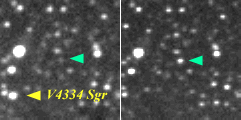 This is a candidate of new object automatically detected by the PIXY system from the 18-cm reflector image of V4334 Sgr on Mar. 22.
Because it was not detected from the 18-cm reflector image of V4334 Sgr on Feb. 12 (detected limiting magnitude is 16.4 mag), it was output as a candidate of new object.
But actually it was also found on them as 16.9 mag.
It is only 110 arcsec from V4334 Sgr.
There are no known variable stars within 5 arcmin except for V4334 Sgr.
No bright star is at this position on the DSS2 image.
We observed it again on Mar. 31 and confirmed that it kept brightening as 14.1 mag.
Then it was registered as a new variable star MisV0001.
This is a candidate of new object automatically detected by the PIXY system from the 18-cm reflector image of V4334 Sgr on Mar. 22.
Because it was not detected from the 18-cm reflector image of V4334 Sgr on Feb. 12 (detected limiting magnitude is 16.4 mag), it was output as a candidate of new object.
But actually it was also found on them as 16.9 mag.
It is only 110 arcsec from V4334 Sgr.
There are no known variable stars within 5 arcmin except for V4334 Sgr.
No bright star is at this position on the DSS2 image.
We observed it again on Mar. 31 and confirmed that it kept brightening as 14.1 mag.
Then it was registered as a new variable star MisV0001.
|
 AGEO 1999-010N
AGEO 1999-010N
R.A. 17h59m48s.23 Decl. -31o16'02".8 8.2C mag
 This is a candidate of nova discovered on the 18-cm reflector image on Mar. 12.
It was also found on the 300-mm camera lens image on Jan. 29 and the 180-mm camera lens image on Feb. 20.
The star brightened in this period as 10.5 mag (Jan. 29), 8.4 mag (Feb. 20), 8.2 mag (Mar. 12).
No data at this position in GSC and USNO-A1.0.
There is no bright star on the DSS2 image.
There are no variable stars within 1 arcmin, although it may be identified with IRAS 17565-3115.
However, this star is a known variable star V1725 Sgr in fact.
Because the position recorded in the GCVS is 93 arcsec from the detected position, I misjudged it as another object.
It was an example that the positional error of an old variable star is sometimes larger than 1 arcmin.
This is a candidate of nova discovered on the 18-cm reflector image on Mar. 12.
It was also found on the 300-mm camera lens image on Jan. 29 and the 180-mm camera lens image on Feb. 20.
The star brightened in this period as 10.5 mag (Jan. 29), 8.4 mag (Feb. 20), 8.2 mag (Mar. 12).
No data at this position in GSC and USNO-A1.0.
There is no bright star on the DSS2 image.
There are no variable stars within 1 arcmin, although it may be identified with IRAS 17565-3115.
However, this star is a known variable star V1725 Sgr in fact.
Because the position recorded in the GCVS is 93 arcsec from the detected position, I misjudged it as another object.
It was an example that the positional error of an old variable star is sometimes larger than 1 arcmin.
|
 AGEO 1999-009F
AGEO 1999-009F
R.A. 16h08m36s.95 Decl. +07o46'00".7 14.3C mag
 This is a candidate of new object automatically detected by the PIXY system from the 18-cm reflector image of SN 1999ac taken on Mar. 3.
It was detected from two images among four images of the same area.
It was not detected from the first image and the last image.
Although a very faint star may be at the position in the first image, nothing in the last image at all.
This object looks different from other stars, like a noise.
The two images this object was detected from are in the quite same composition, so the pixel's (x,y) coordinates of the object are also quite same.
Therefore, it should be a noise, not a real celestial object.
This is a candidate of new object automatically detected by the PIXY system from the 18-cm reflector image of SN 1999ac taken on Mar. 3.
It was detected from two images among four images of the same area.
It was not detected from the first image and the last image.
Although a very faint star may be at the position in the first image, nothing in the last image at all.
This object looks different from other stars, like a noise.
The two images this object was detected from are in the quite same composition, so the pixel's (x,y) coordinates of the object are also quite same.
Therefore, it should be a noise, not a real celestial object.
|
 AGEO 1999-008C
AGEO 1999-008C
R.A. 06h38m09s.8 Decl. +27o51'13" 15.5C mag
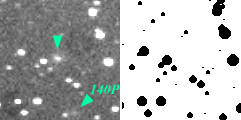 This is a cometary object found on the 18-cm reflector image of Comet 140P/Bowell-Skiff taken on Feb. 7.
It was very close to Comet 140P/Bowell-Skiff.
In the right chart, plotting USNO-A1.0 stars brighter than 19 mag, this object is not found.
However, it was found on the DSS image.
So the object is not a new comet but a normal galaxy.
This is a cometary object found on the 18-cm reflector image of Comet 140P/Bowell-Skiff taken on Feb. 7.
It was very close to Comet 140P/Bowell-Skiff.
In the right chart, plotting USNO-A1.0 stars brighter than 19 mag, this object is not found.
However, it was found on the DSS image.
So the object is not a new comet but a normal galaxy.
|
 AGEO 1999-007C
AGEO 1999-007C
R.A. 16h58m01s.82 Decl. -04o33'21".1 12.3C mag

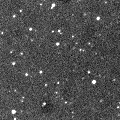 This is a cometary object found on the 300-mm camera lens image of the globular cluster M4 taken on Feb. 3.
It was automatically detected by the PIXY system as a candidate of new object.
The object looks moving.
However, it was not in another image of the same night (right image) in different composition.
In addition, there is Antares on the other side against the center.
So the object is a ghost of Antares.
This is a cometary object found on the 300-mm camera lens image of the globular cluster M4 taken on Feb. 3.
It was automatically detected by the PIXY system as a candidate of new object.
The object looks moving.
However, it was not in another image of the same night (right image) in different composition.
In addition, there is Antares on the other side against the center.
So the object is a ghost of Antares.
|
 AGEO 1999-006N
AGEO 1999-006N
R.A. 18h00m39s.97 Decl. -31o26'06".2 9.9C mag
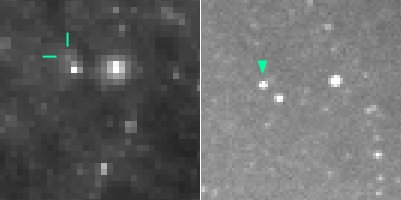 This is a candidate of new object automatically detected by the PIXY system from the 300-mm camera lens image of Nova Sco 1998 taken on Jan. 29 (right image).
It's not clear on the 105-mm camera lens image on Jun. 20, 1998 (left image) if this star exists or not.
There is a data GSC7391.1858 at this position in the GSC, so this should be a normal star.
But it may be variable.
Therefore we observe it again on Mar. 12, when this star was as same as on Jan. 29.
So it is a normal star.
This is a candidate of new object automatically detected by the PIXY system from the 300-mm camera lens image of Nova Sco 1998 taken on Jan. 29 (right image).
It's not clear on the 105-mm camera lens image on Jun. 20, 1998 (left image) if this star exists or not.
There is a data GSC7391.1858 at this position in the GSC, so this should be a normal star.
But it may be variable.
Therefore we observe it again on Mar. 12, when this star was as same as on Jan. 29.
So it is a normal star.
|
 AGEO 1999-005N
AGEO 1999-005N
R.A. 07h11m10s.61 Decl. +40o02'57".1 14.2C mag
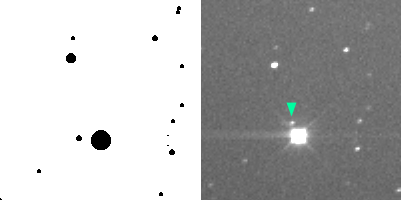 This is a candidate of new object automatically detected by the PIXY system from the 18-cm reflector image of Comet 52P/Harrington-Abell taken on Jan. 10.
It is just beside of 7-mag star.
There is no data in the USNO-A1.0.
On the other hand, there is another star east of the 7-mag star in the USNO-A1.0, but it was not found on the image.
This star was not found clearly on the the 12-cm reflector image of Comet 52P/Harrington-Abell taken on Jan. 12, probably because it is too close to a bright star, and the system judged it as a candidate of new object.
But further observation on Mar. 13 with 18-cm reflector revealed it as a normal star.
This star is also found on the DSS image.
This is a candidate of new object automatically detected by the PIXY system from the 18-cm reflector image of Comet 52P/Harrington-Abell taken on Jan. 10.
It is just beside of 7-mag star.
There is no data in the USNO-A1.0.
On the other hand, there is another star east of the 7-mag star in the USNO-A1.0, but it was not found on the image.
This star was not found clearly on the the 12-cm reflector image of Comet 52P/Harrington-Abell taken on Jan. 12, probably because it is too close to a bright star, and the system judged it as a candidate of new object.
But further observation on Mar. 13 with 18-cm reflector revealed it as a normal star.
This star is also found on the DSS image.
|
 AGEO 1999-004N = MisV0064
AGEO 1999-004N = MisV0064
R.A. 17h55m12s.6 Decl. -31o01'20" 15C mag
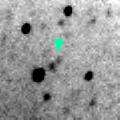 This star was found on the image of Nova Sco 1998 taken on Jan. 27.
There is no star at this point in USNO-A1.0.
No variable star except for Nova Sco 1998 is found within 3 arcmin.
So it might be a nova.
However, this star was also found on another image of Nova Sco 1998 introduced us in [vsnet-alert 2296].
So it was not a nova in fact.
This case shows that there are many stars not recorded in star catalog around this area.
Careful check is required in survey work.
However, we discovered the variability of this star after while and it was registered as a new variable star MisV0064.
This star was found on the image of Nova Sco 1998 taken on Jan. 27.
There is no star at this point in USNO-A1.0.
No variable star except for Nova Sco 1998 is found within 3 arcmin.
So it might be a nova.
However, this star was also found on another image of Nova Sco 1998 introduced us in [vsnet-alert 2296].
So it was not a nova in fact.
This case shows that there are many stars not recorded in star catalog around this area.
Careful check is required in survey work.
However, we discovered the variability of this star after while and it was registered as a new variable star MisV0064.
|
 AGEO 1999-003C
AGEO 1999-003C
R.A. 19h12m52s.22 Decl. +49o31'01".8 12.6C mag
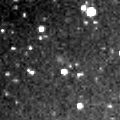 This is a cometary object found on the 180-mm camera lens survey image taken on Jan. 17 around Comet C/1998 M5 (LINEAR) .
It was automatically detected by the PIXY system as a candidate of new object.
There are no IRAS objects, nebulae, or clusters within 5 arcmin.
Confirmation on Jan. 20 with 300-mm camera lens makes it clear that some faint stars looked cometary.
This is a cometary object found on the 180-mm camera lens survey image taken on Jan. 17 around Comet C/1998 M5 (LINEAR) .
It was automatically detected by the PIXY system as a candidate of new object.
There are no IRAS objects, nebulae, or clusters within 5 arcmin.
Confirmation on Jan. 20 with 300-mm camera lens makes it clear that some faint stars looked cometary.
|
 AGEO 1999-002F
AGEO 1999-002F
R.A. 06h55m55s.81 Decl. +30o58'07".0 10.2C mag
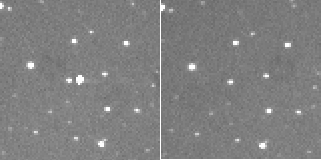 This is a candidate of new object automatically detected by the PIXY system from the 18-cm reflector image of Comet D/1998 Y1 (LINEAR) taken on Jan. 10.
It was regarded as a noise because it did not detected from another image of the same area on that night, and the image of this object looked different from other real stars.
A noise generally appears in one pixel, but in this case, the noise is speading over several pixels.
By the way, such a candidate only detected from one image are removed automatically now.
Please read New Object Survey for more details.
This is a candidate of new object automatically detected by the PIXY system from the 18-cm reflector image of Comet D/1998 Y1 (LINEAR) taken on Jan. 10.
It was regarded as a noise because it did not detected from another image of the same area on that night, and the image of this object looked different from other real stars.
A noise generally appears in one pixel, but in this case, the noise is speading over several pixels.
By the way, such a candidate only detected from one image are removed automatically now.
Please read New Object Survey for more details.
|
 AGEO 1999-001C
AGEO 1999-001C
R.A. 19h09m58s.37 Decl. +43o24'57".8 9.3C mag

 This is a candidate of new comet automatically detected by the PIXY system from the 300-mm camera lens images of Comet C/1998 M5 (LINEAR) taken on Jan. 9.
The object was detected from two images.
It looked cometary and was moving between 4 minutes and 13 seconds.
However the image of the object looked a ghost of a bright star, not a real comet.
Anyway, when we found this object, it was too late to search it again.
This is a candidate of new comet automatically detected by the PIXY system from the 300-mm camera lens images of Comet C/1998 M5 (LINEAR) taken on Jan. 9.
The object was detected from two images.
It looked cometary and was moving between 4 minutes and 13 seconds.
However the image of the object looked a ghost of a bright star, not a real comet.
Anyway, when we found this object, it was too late to search it again.
|
 AGEO 1998-005N
AGEO 1998-005N
R.A. 05h24m.3 Decl. +05o59' 0R mag
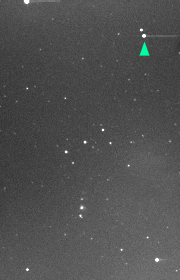 This is a candidate of new nova automatically detected by the PIXY system from the 16-mm wide camera lens image of Orion taken on Oct. 10.
It locates near by gamma-Ori.
It is fainter than Betelgeuse but brighter than Rigel.
Because we took only one image on the night, just for test, nothing is clear about this object.
Maybe it is an artificial satellite or meteor, but the image looks like an ordinary star.
This is a candidate of new nova automatically detected by the PIXY system from the 16-mm wide camera lens image of Orion taken on Oct. 10.
It locates near by gamma-Ori.
It is fainter than Betelgeuse but brighter than Rigel.
Because we took only one image on the night, just for test, nothing is clear about this object.
Maybe it is an artificial satellite or meteor, but the image looks like an ordinary star.
|
 AGEO 1998-004V = MisV0002
AGEO 1998-004V = MisV0002
R.A. 07h24m03s.56 Decl. +41o26'02".0 13.4C mag
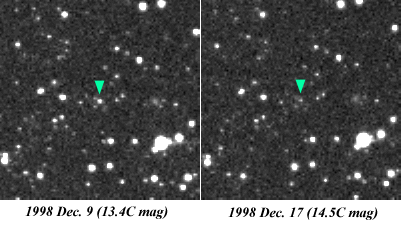 This is a variable object detected from the 300-mm camera lens or 18-cm reflector images of Comet 52P/Harrington-Abell taken between Dec. 9 and 20.
The magnitude estimated by the PIXY system show that this object is about one mag fainter than usual on Dec. 17.
Because it is as bright as usual on the next day, it is probably an eclipsing binary.
It is registered as a new variable star MisV0002.
This is a variable object detected from the 300-mm camera lens or 18-cm reflector images of Comet 52P/Harrington-Abell taken between Dec. 9 and 20.
The magnitude estimated by the PIXY system show that this object is about one mag fainter than usual on Dec. 17.
Because it is as bright as usual on the next day, it is probably an eclipsing binary.
It is registered as a new variable star MisV0002.
|
 AGEO 1998-003C
AGEO 1998-003C
R.A. 07h27m45s.79 Decl. +41o10'39".8 12.9C mag
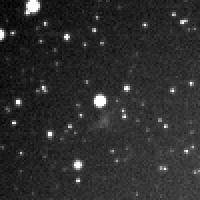 This is a candidate of new comet automatically detected by the PIXY system from the 300-mm camera lens images of Comet 52P/Harrington-Abell taken on Dec. 9.
The object was detected from all five images.
It looked cometary and moving.
The motion is well corresponding, however, it slips off only in the fourth image.
In addition, there is a bright star 66 Aur (5.2 mag) on the other side against the center.
So the object is a ghost of this bright star.
This is a candidate of new comet automatically detected by the PIXY system from the 300-mm camera lens images of Comet 52P/Harrington-Abell taken on Dec. 9.
The object was detected from all five images.
It looked cometary and moving.
The motion is well corresponding, however, it slips off only in the fourth image.
In addition, there is a bright star 66 Aur (5.2 mag) on the other side against the center.
So the object is a ghost of this bright star.
|
 AGEO 1998-002F
AGEO 1998-002F
R.A. 07h17m20s.39 Decl. +39o52'35".9 14.6C mag
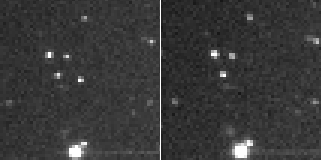 This is a candidate of new object automatically detected by the PIXY system from the 12-cm reflector images of Comet 52P/Harrington-Abell taken on Nov. 19.
But the object was not detected from another image of the same area on that night.
So it is a noise.
Stars in this image are very sharp and the noise looks very similar to real stars around.
This is an example that the judgement of noises is impossible only based on the image of the object and several images are required for it.
This is a candidate of new object automatically detected by the PIXY system from the 12-cm reflector images of Comet 52P/Harrington-Abell taken on Nov. 19.
But the object was not detected from another image of the same area on that night.
So it is a noise.
Stars in this image are very sharp and the noise looks very similar to real stars around.
This is an example that the judgement of noises is impossible only based on the image of the object and several images are required for it.
|
 AGEO 1998-001S
AGEO 1998-001S
R.A. 11h48m33s.99 Decl. +48o43'10".9 13.8C mag
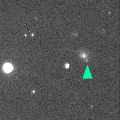 This is a candidate of new object automatically detected by the PIXY system from the 400-mm camera lens images of Supernova 1998S taken on Mar. 7.
It is near by a galaxy NGC 3893, so it may be a supernova.
However, this object was also found on the DSS image.
So it is a normal star.
This is a candidate of new object automatically detected by the PIXY system from the 400-mm camera lens images of Supernova 1998S taken on Mar. 7.
It is near by a galaxy NGC 3893, so it may be a supernova.
However, this object was also found on the DSS image.
So it is a normal star.
|
|
 This is a candidate of new object automatically detected by the PIXY system from the survey images on June 5.
Because no star was detected from the 300-mm camera lens images of Comet C/1998 M5 (LINEAR) on Sept. 12, 1998, it was output as a candidate of new object.
However, we can see a very diffused image at that position on the left image.
Many stars become diffused, like this one, on images taken with a CCD and camera lens.
When a star becomes extremely diffused, it is hard to find the star on the image.
Therefore, be careful to compare camera lens images with reflector images.
This is a candidate of new object automatically detected by the PIXY system from the survey images on June 5.
Because no star was detected from the 300-mm camera lens images of Comet C/1998 M5 (LINEAR) on Sept. 12, 1998, it was output as a candidate of new object.
However, we can see a very diffused image at that position on the left image.
Many stars become diffused, like this one, on images taken with a CCD and camera lens.
When a star becomes extremely diffused, it is hard to find the star on the image.
Therefore, be careful to compare camera lens images with reflector images.
 AGEO 1999-011V = MisV0001
AGEO 1999-011V = MisV0001 This is a candidate of new object automatically detected by the PIXY system from the 18-cm reflector image of V4334 Sgr on Mar. 22.
Because it was not detected from the 18-cm reflector image of V4334 Sgr on Feb. 12 (detected limiting magnitude is 16.4 mag), it was output as a candidate of new object.
But actually it was also found on them as 16.9 mag.
It is only 110 arcsec from V4334 Sgr.
There are no known variable stars within 5 arcmin except for V4334 Sgr.
No bright star is at this position on the DSS2 image.
We observed it again on Mar. 31 and confirmed that it kept brightening as 14.1 mag.
Then it was registered as a new variable star MisV0001.
This is a candidate of new object automatically detected by the PIXY system from the 18-cm reflector image of V4334 Sgr on Mar. 22.
Because it was not detected from the 18-cm reflector image of V4334 Sgr on Feb. 12 (detected limiting magnitude is 16.4 mag), it was output as a candidate of new object.
But actually it was also found on them as 16.9 mag.
It is only 110 arcsec from V4334 Sgr.
There are no known variable stars within 5 arcmin except for V4334 Sgr.
No bright star is at this position on the DSS2 image.
We observed it again on Mar. 31 and confirmed that it kept brightening as 14.1 mag.
Then it was registered as a new variable star MisV0001.
 AGEO 1999-010N
AGEO 1999-010N This is a candidate of nova discovered on the 18-cm reflector image on Mar. 12.
It was also found on the 300-mm camera lens image on Jan. 29 and the 180-mm camera lens image on Feb. 20.
The star brightened in this period as 10.5 mag (Jan. 29), 8.4 mag (Feb. 20), 8.2 mag (Mar. 12).
No data at this position in GSC and USNO-A1.0.
There is no bright star on the DSS2 image.
There are no variable stars within 1 arcmin, although it may be identified with IRAS 17565-3115.
However, this star is a known variable star V1725 Sgr in fact.
Because the position recorded in the GCVS is 93 arcsec from the detected position, I misjudged it as another object.
It was an example that the positional error of an old variable star is sometimes larger than 1 arcmin.
This is a candidate of nova discovered on the 18-cm reflector image on Mar. 12.
It was also found on the 300-mm camera lens image on Jan. 29 and the 180-mm camera lens image on Feb. 20.
The star brightened in this period as 10.5 mag (Jan. 29), 8.4 mag (Feb. 20), 8.2 mag (Mar. 12).
No data at this position in GSC and USNO-A1.0.
There is no bright star on the DSS2 image.
There are no variable stars within 1 arcmin, although it may be identified with IRAS 17565-3115.
However, this star is a known variable star V1725 Sgr in fact.
Because the position recorded in the GCVS is 93 arcsec from the detected position, I misjudged it as another object.
It was an example that the positional error of an old variable star is sometimes larger than 1 arcmin.
 AGEO 1999-009F
AGEO 1999-009F
 AGEO 1999-008C
AGEO 1999-008C This is a cometary object found on the 18-cm reflector image of Comet 140P/Bowell-Skiff taken on Feb. 7.
It was very close to Comet 140P/Bowell-Skiff.
In the right chart, plotting USNO-A1.0 stars brighter than 19 mag, this object is not found.
However, it was found on the DSS image.
So the object is not a new comet but a normal galaxy.
This is a cometary object found on the 18-cm reflector image of Comet 140P/Bowell-Skiff taken on Feb. 7.
It was very close to Comet 140P/Bowell-Skiff.
In the right chart, plotting USNO-A1.0 stars brighter than 19 mag, this object is not found.
However, it was found on the DSS image.
So the object is not a new comet but a normal galaxy.
 AGEO 1999-007C
AGEO 1999-007C
 This is a cometary object found on the 300-mm camera lens image of the globular cluster M4 taken on Feb. 3.
It was automatically detected by the PIXY system as a candidate of new object.
The object looks moving.
However, it was not in another image of the same night (right image) in different composition.
In addition, there is Antares on the other side against the center.
So the object is a ghost of Antares.
This is a cometary object found on the 300-mm camera lens image of the globular cluster M4 taken on Feb. 3.
It was automatically detected by the PIXY system as a candidate of new object.
The object looks moving.
However, it was not in another image of the same night (right image) in different composition.
In addition, there is Antares on the other side against the center.
So the object is a ghost of Antares.
 AGEO 1999-006N
AGEO 1999-006N This is a candidate of new object automatically detected by the PIXY system from the 300-mm camera lens image of Nova Sco 1998 taken on Jan. 29 (right image).
It's not clear on the 105-mm camera lens image on Jun. 20, 1998 (left image) if this star exists or not.
There is a data GSC7391.1858 at this position in the GSC, so this should be a normal star.
But it may be variable.
Therefore we observe it again on Mar. 12, when this star was as same as on Jan. 29.
So it is a normal star.
This is a candidate of new object automatically detected by the PIXY system from the 300-mm camera lens image of Nova Sco 1998 taken on Jan. 29 (right image).
It's not clear on the 105-mm camera lens image on Jun. 20, 1998 (left image) if this star exists or not.
There is a data GSC7391.1858 at this position in the GSC, so this should be a normal star.
But it may be variable.
Therefore we observe it again on Mar. 12, when this star was as same as on Jan. 29.
So it is a normal star.
 AGEO 1999-005N
AGEO 1999-005N This is a candidate of new object automatically detected by the PIXY system from the 18-cm reflector image of Comet 52P/Harrington-Abell taken on Jan. 10.
It is just beside of 7-mag star.
There is no data in the USNO-A1.0.
On the other hand, there is another star east of the 7-mag star in the USNO-A1.0, but it was not found on the image.
This star was not found clearly on the the 12-cm reflector image of Comet 52P/Harrington-Abell taken on Jan. 12, probably because it is too close to a bright star, and the system judged it as a candidate of new object.
But further observation on Mar. 13 with 18-cm reflector revealed it as a normal star.
This star is also found on the DSS image.
This is a candidate of new object automatically detected by the PIXY system from the 18-cm reflector image of Comet 52P/Harrington-Abell taken on Jan. 10.
It is just beside of 7-mag star.
There is no data in the USNO-A1.0.
On the other hand, there is another star east of the 7-mag star in the USNO-A1.0, but it was not found on the image.
This star was not found clearly on the the 12-cm reflector image of Comet 52P/Harrington-Abell taken on Jan. 12, probably because it is too close to a bright star, and the system judged it as a candidate of new object.
But further observation on Mar. 13 with 18-cm reflector revealed it as a normal star.
This star is also found on the DSS image.
 AGEO 1999-004N = MisV0064
AGEO 1999-004N = MisV0064 This star was found on the image of Nova Sco 1998 taken on Jan. 27.
There is no star at this point in USNO-A1.0.
No variable star except for Nova Sco 1998 is found within 3 arcmin.
So it might be a nova.
However, this star was also found on another image of Nova Sco 1998 introduced us in [vsnet-alert 2296].
So it was not a nova in fact.
This case shows that there are many stars not recorded in star catalog around this area.
Careful check is required in survey work.
However, we discovered the variability of this star after while and it was registered as a new variable star MisV0064.
This star was found on the image of Nova Sco 1998 taken on Jan. 27.
There is no star at this point in USNO-A1.0.
No variable star except for Nova Sco 1998 is found within 3 arcmin.
So it might be a nova.
However, this star was also found on another image of Nova Sco 1998 introduced us in [vsnet-alert 2296].
So it was not a nova in fact.
This case shows that there are many stars not recorded in star catalog around this area.
Careful check is required in survey work.
However, we discovered the variability of this star after while and it was registered as a new variable star MisV0064.
 AGEO 1999-003C
AGEO 1999-003C This is a cometary object found on the 180-mm camera lens survey image taken on Jan. 17 around Comet C/1998 M5 (LINEAR) .
It was automatically detected by the PIXY system as a candidate of new object.
There are no IRAS objects, nebulae, or clusters within 5 arcmin.
Confirmation on Jan. 20 with 300-mm camera lens makes it clear that some faint stars looked cometary.
This is a cometary object found on the 180-mm camera lens survey image taken on Jan. 17 around Comet C/1998 M5 (LINEAR) .
It was automatically detected by the PIXY system as a candidate of new object.
There are no IRAS objects, nebulae, or clusters within 5 arcmin.
Confirmation on Jan. 20 with 300-mm camera lens makes it clear that some faint stars looked cometary.
 AGEO 1999-002F
AGEO 1999-002F This is a candidate of new object automatically detected by the PIXY system from the 18-cm reflector image of Comet D/1998 Y1 (LINEAR) taken on Jan. 10.
It was regarded as a noise because it did not detected from another image of the same area on that night, and the image of this object looked different from other real stars.
A noise generally appears in one pixel, but in this case, the noise is speading over several pixels.
By the way, such a candidate only detected from one image are removed automatically now.
Please read New Object Survey for more details.
This is a candidate of new object automatically detected by the PIXY system from the 18-cm reflector image of Comet D/1998 Y1 (LINEAR) taken on Jan. 10.
It was regarded as a noise because it did not detected from another image of the same area on that night, and the image of this object looked different from other real stars.
A noise generally appears in one pixel, but in this case, the noise is speading over several pixels.
By the way, such a candidate only detected from one image are removed automatically now.
Please read New Object Survey for more details.
 AGEO 1999-001C
AGEO 1999-001C
 This is a candidate of new comet automatically detected by the PIXY system from the 300-mm camera lens images of Comet C/1998 M5 (LINEAR) taken on Jan. 9.
The object was detected from two images.
It looked cometary and was moving between 4 minutes and 13 seconds.
However the image of the object looked a ghost of a bright star, not a real comet.
Anyway, when we found this object, it was too late to search it again.
This is a candidate of new comet automatically detected by the PIXY system from the 300-mm camera lens images of Comet C/1998 M5 (LINEAR) taken on Jan. 9.
The object was detected from two images.
It looked cometary and was moving between 4 minutes and 13 seconds.
However the image of the object looked a ghost of a bright star, not a real comet.
Anyway, when we found this object, it was too late to search it again.
 AGEO 1998-005N
AGEO 1998-005N This is a candidate of new nova automatically detected by the PIXY system from the 16-mm wide camera lens image of Orion taken on Oct. 10.
It locates near by gamma-Ori.
It is fainter than Betelgeuse but brighter than Rigel.
Because we took only one image on the night, just for test, nothing is clear about this object.
Maybe it is an artificial satellite or meteor, but the image looks like an ordinary star.
This is a candidate of new nova automatically detected by the PIXY system from the 16-mm wide camera lens image of Orion taken on Oct. 10.
It locates near by gamma-Ori.
It is fainter than Betelgeuse but brighter than Rigel.
Because we took only one image on the night, just for test, nothing is clear about this object.
Maybe it is an artificial satellite or meteor, but the image looks like an ordinary star.
 AGEO 1998-004V = MisV0002
AGEO 1998-004V = MisV0002 This is a variable object detected from the 300-mm camera lens or 18-cm reflector images of Comet 52P/Harrington-Abell taken between Dec. 9 and 20.
The magnitude estimated by the PIXY system show that this object is about one mag fainter than usual on Dec. 17.
Because it is as bright as usual on the next day, it is probably an eclipsing binary.
It is registered as a new variable star MisV0002.
This is a variable object detected from the 300-mm camera lens or 18-cm reflector images of Comet 52P/Harrington-Abell taken between Dec. 9 and 20.
The magnitude estimated by the PIXY system show that this object is about one mag fainter than usual on Dec. 17.
Because it is as bright as usual on the next day, it is probably an eclipsing binary.
It is registered as a new variable star MisV0002.
 AGEO 1998-003C
AGEO 1998-003C This is a candidate of new comet automatically detected by the PIXY system from the 300-mm camera lens images of Comet 52P/Harrington-Abell taken on Dec. 9.
The object was detected from all five images.
It looked cometary and moving.
The motion is well corresponding, however, it slips off only in the fourth image.
In addition, there is a bright star 66 Aur (5.2 mag) on the other side against the center.
So the object is a ghost of this bright star.
This is a candidate of new comet automatically detected by the PIXY system from the 300-mm camera lens images of Comet 52P/Harrington-Abell taken on Dec. 9.
The object was detected from all five images.
It looked cometary and moving.
The motion is well corresponding, however, it slips off only in the fourth image.
In addition, there is a bright star 66 Aur (5.2 mag) on the other side against the center.
So the object is a ghost of this bright star.
 AGEO 1998-002F
AGEO 1998-002F This is a candidate of new object automatically detected by the PIXY system from the 12-cm reflector images of Comet 52P/Harrington-Abell taken on Nov. 19.
But the object was not detected from another image of the same area on that night.
So it is a noise.
Stars in this image are very sharp and the noise looks very similar to real stars around.
This is an example that the judgement of noises is impossible only based on the image of the object and several images are required for it.
This is a candidate of new object automatically detected by the PIXY system from the 12-cm reflector images of Comet 52P/Harrington-Abell taken on Nov. 19.
But the object was not detected from another image of the same area on that night.
So it is a noise.
Stars in this image are very sharp and the noise looks very similar to real stars around.
This is an example that the judgement of noises is impossible only based on the image of the object and several images are required for it.
 AGEO 1998-001S
AGEO 1998-001S This is a candidate of new object automatically detected by the PIXY system from the 400-mm camera lens images of Supernova 1998S taken on Mar. 7.
It is near by a galaxy NGC 3893, so it may be a supernova.
However, this object was also found on the DSS image.
So it is a normal star.
This is a candidate of new object automatically detected by the PIXY system from the 400-mm camera lens images of Supernova 1998S taken on Mar. 7.
It is near by a galaxy NGC 3893, so it may be a supernova.
However, this object was also found on the DSS image.
So it is a normal star.
